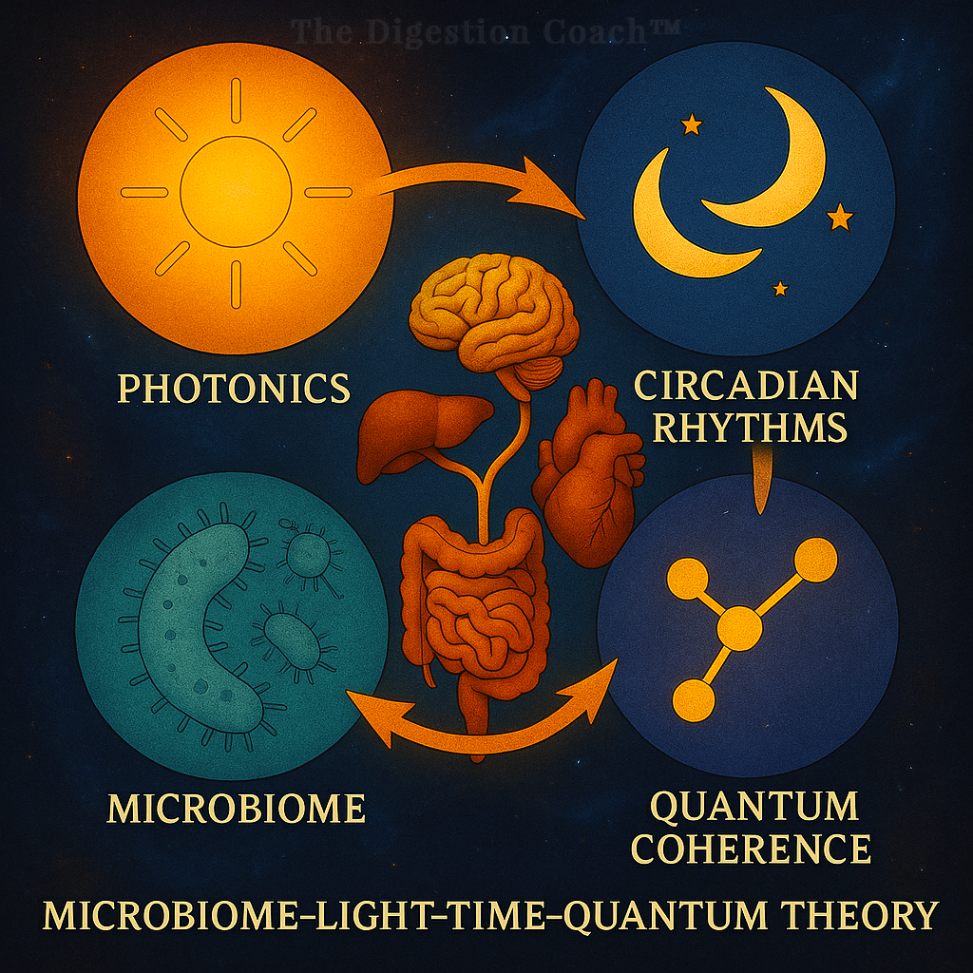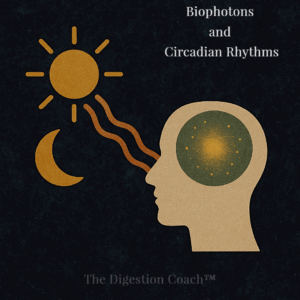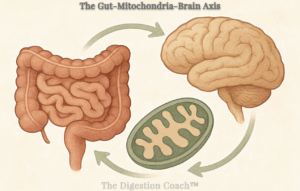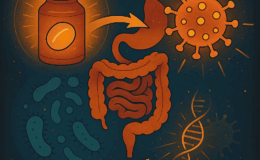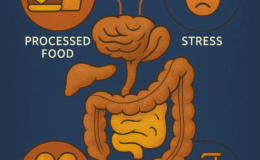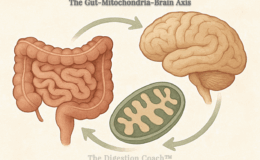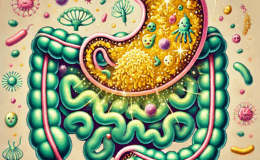Microbiome-Light-Time-Quantum Theory
Imagine life as a system where light, time, and gut microbes interact, guided by the principles of quantum mechanics. This is my Microbiome-Light-Time-Quantum Theory, which sees every living thing—you, me, even our gut bacteria—as experts in energy, timing, and hidden connections. I propose four key components: photonics, capturing light’s power; circadian rhythms, synchronizing us with time; quantum coherence, utilizing quantum precision for enhanced efficiency; and the microbiome, orchestrating these processes through ultra-weak biophotons and microbial metabolites. The microbiome is comprised of trillions of gut microbes that send these signals through pathways such as the gut-brain, gut-liver, gut-immune, gut-skin, gut-hormone, and gut-lung axes. Gut axes relay microbial signals to synchronize photonics, rhythms, and coherence, forming a network that connects every cell in your body. My Microbiome-Light-Time-Quantum Theory helps to explain how gut bacteria, through biophotons, circadian rhythms, and quantum processes, work to maintain health and homeostasis across every body system. This article explores the theory through these four components, evaluates its strengths and limitations in human and quantum biology, and envisions its potential to inspire light-based therapies and microbial interventions.
Photonics: Harnessing Light’s Energy
Photonics is how life captures light’s energy, like plants using sunlight or your eyes seeing the world. A key player is tryptophan, an amino acid in proteins that acts like a cellular antenna, absorbing UV light at 280 nm. A 2024 study and historical research found that tryptophan in cell structures called microtubules can work together in a quantum process called superradiance, potentially boosting UV absorption by up to 4,000 times [4,52]. Think of it like a choir singing in perfect harmony to amplify sound—tryptophan molecules sync up to capture light more efficiently.
Your gut microbiome may enhance this light system. Gut bacteria emit ultra-weak biophotons—faint light signals in the UV-to-visible range—potentially acting like tiny cellular flashlights [6,36]. Gurwitsch demonstrated that metabolically active cells, including microorganisms, emit ultra-weak UV photons (190–280 nm), termed mitogenetic rays, which trigger cell division, supporting the hypothesis that gut bacteria use biophotons for signaling [52]. These biophotons, produced during chemical reactions like oxygen bursts, might support cell signaling, possibly linking the gut to the brain or skin [2,38]. While this idea is still a hypothesis, it suggests gut microbes could amplify light-driven communication across your body.
Other molecules, like cryptochromes and melanin, also capture light. Cryptochromes sense blue light to fine-tune your body’s clock, while melanin in your skin absorbs UV to protect DNA [10,33]. Through the gut axes network (see The Gut Axes Network), microbial signals like biophotons and short-chain fatty acids (SCFAs) may integrate these light-driven processes, supporting health from your brain to skin [12,15].
Circadian Rhythms: Syncing with Time
Circadian rhythms are your body’s 24-hour clock, aligning sleep, energy, and metabolism with the day-night cycle, whether it’s sunlight or overhead LEDs. Think of it like an orchestra conductor, keeping every cell in sync. Gut microbes, along with molecules like tryptophan, help fine-tune this rhythm.
Tryptophan, an amino acid, transforms into melatonin, a hormone that signals nighttime to your brain, promoting sleep. Light, detected by melanopsin in your eyes (~480 nm blue light), suppresses melatonin, while darkness boosts it, keeping your clock steady [9]. Cryptochromes, light-sensitive proteins, further refine this timing across your body, using quantum effects in radical pairs to sync clock genes like CLOCK and BMAL1 [10]. Gut bacteria may amplify this system. For example, bacteria like Serratia marcescens emit ultra-weak biophotons—tiny light signals tied to metabolism—that might influence melatonin or clock genes in the brain, liver, or skin. Biophoton emissions also shift with bacterial growth or stress, suggesting a role in local light-driven signaling in the gut [7,8,30,36]. This idea is a hypothesis, as direct evidence is still needed.
Gut microbes also produce flavins, molecules that absorb blue light and emit biophotons, potentially syncing daily rhythms [2,8]. Short-chain fatty acids (SCFAs), like butyrate, made by gut bacteria, further influence clock genes, regulating metabolism, sleep, and hormones [30,41,46]. Through the gut axes network (see The Gut Axes Network), these microbial signals—biophotons, SCFAs, and tryptophan metabolites—connect the gut to the brain, liver, skin, and lungs, ensuring your body’s rhythms stay in harmony [6,12,13,14,15].
Quantum Coherence: Life’s Quantum Edge
Quantum coherence is like a perfectly synchronized dance of particles—electrons or photons—moving in harmony to transfer energy or information with pinpoint precision. In living systems, this quantum edge appears in processes like photosynthesis in plants or navigation in birds, where particles lock into synchronized states [20,10,42]. I propose that quantum coherence also shapes human health, with gut microbes playing a surprising role.
Inspired by the Orch-OR theory, I hypothesize that microtubules—tiny tubes in cells rich in tryptophan—act as quantum hubs, channeling light and vibrational signals across the body, including the gut microbiome [5,34]. Gurwitsch’s concept of non-equilibrium molecular constellations—groups of excited molecules sustaining energy circulation—suggests a historical precedent for quantum coherence in biological systems, potentially relevant to microtubule signaling [52]. These microtubules may enable brief moments of quantum coherence, syncing processes like circadian rhythms or gut-brain signaling. For example, tryptophan’s superradiance, a quantum effect, amplifies light absorption, potentially supporting coherent biophoton signals [4,6]. However, cells are warm and wet, causing rapid decoherence—quantum states collapse in 10^-13 to 10^-10 seconds*—making long-term coherence challenging [17,26]. The Orch-OR theory, though debated, suggests these fleeting quantum moments are possible and biologically significant [5]. *The range 10^-13 to 10^-10 seconds spans 100 femtoseconds to 100 picoseconds.
Gut microbes may enhance this quantum edge. Their short-chain fatty acids (SCFAs) and tryptophan metabolites reduce harmful reactive oxygen species (ROS), potentially stabilizing microtubules for brief quantum states [12,15,18]. Biophotons emitted by gut bacteria could also contribute to coherent signaling across the gut axes network (see The Gut Axes Network), though this is a hypothesis needing further study [6,28]. By integrating quantum precision with microbial signals, this system may fine-tune health across the body, from the brain to the immune system.
The Microbiome: The Body’s Orchestrator
Your gut microbiome, a bustling community of trillions of microbes, acts like an orchestra conductor, harmonizing light, time, and quantum signals across your body. Through pathways called gut axes—linking gut to brain, liver, immune system, skin, hormones, and lungs—it integrates photonics, circadian rhythms, and quantum coherence to maintain health [6,36].
A key mechanism is biophotons—ultra-weak light signals emitted by gut bacteria during chemical reactions, like those involving reactive oxygen species (ROS) or tryptophan [2,8,21]. These biophotons, varying with bacterial density, may support cell signaling across gut axes, potentially influencing liver metabolism, skin melanin production, or lung chemistry [36,38,44]. Microorganisms have been shown to emit ultra-weak UV photons during enzymatic reactions like glycolysis, with distinct spectral bands tied to substances like glucose, suggesting gut bacteria may produce unique biophoton signatures for signaling [52]. For example, diverse microbes like Lactobacillus and Bacteroides could shape biophoton patterns, though this is a hypothesis needing further study [36].
Microtubules, cellular structures rich in tryptophan, amplify this network by channeling light signals via superradiance, while mitochondria, the cell’s powerhouses, shuttle signaling molecules along these microtubules [4,5,22,23,34]. Through the gut axes network (see The Gut Axes Network), the microbiome ensures continuous communication, keeping every body system in balance 24/7.
The Gut Axes Network
The gut microbiome acts like a central hub, sending signals through many pathways—called gut axes—to coordinate light, time, and quantum processes across your body. These axes, like communication lines, relay microbial signals such as short-chain fatty acids (SCFAs), tryptophan metabolites, and ultra-weak biophotons to maintain balance (homeostasis) in every system [6,12,15].
- Gut-to-Brain Axis: SCFAs like butyrate energize brain cells, while tryptophan metabolites, such as serotonin precursors, support mood and sleep. Biophotons may enhance neural signaling, though this is a hypothesis needing study [12,16,31].
- Gut-to-Liver Axis: Microbes modify bile acids to regulate liver metabolism, with tryptophan metabolites reducing inflammation and syncing liver rhythms [14,48,49].
- Gut-to-Immune Axis: SCFAs lower inflammation, stabilizing cellular signaling. Immune molecules (cytokines) fine-tune microbial activity [15].
- Gut-to-Skin Axis: SCFAs from gut and skin microbiota enhance skin barrier integrity and mitigate UV-induced inflammation to shield against UV damage, potentially reducing hyperpigmentation; skin microbes may emit biophotons to sync rhythms, a hypothesis requiring further research [13,21].
- Gut-to-Hormone Axis: Microbial signals balance hormones like melatonin and cortisol, supporting rhythmic and light-driven processes [15].
- Gut-to-Lung Axis: SCFAs reduce lung inflammation, potentially aiding biophoton-driven signaling and rhythm synchronization, though evidence is preliminary [15].
- Gut-Mitochondria-Brain Axis – Dr. Ettinger blog post.
These axes form a dynamic network, with two-way communication between the microbiome and body systems, ensuring health through light, time, and quantum harmony [6,12].
Strengths and Limitations of the Microbiome-Light-Time-Quantum Theory
The Biophotons theme explores light signals from cells, with promising but limited health applications.
| Theme | Strengths | Limitations |
|---|---|---|
| Biophotons (Human & Quantum Biology) |
|
The Biophotons theme explores light signals from cells, with promising but limited health applications.
| Theme | Strengths | Limitations |
|---|---|---|
| Biophotons (Human & Quantum Biology) |
The Circadian Rhythms theme highlights strong evidence for microbial rhythm regulation, with speculative biophoton roles.
| Theme | Strengths | Limitations |
|---|---|---|
| Circadian Rhythms (Human Biology) |
|
The Quantum Coherence theme shows quantum effects in biology, but human applications remain unproven.
| Theme | Strengths | Limitations |
|---|---|---|
| Quantum Coherence (Quantum Biology) |
This analysis shows the theory’s promise in linking microbiome and circadian research with quantum possibilities. While human biology evidence is strong, biophotons and quantum coherence need more study. Future experiments, like measuring biophoton changes in gut health, could unlock new therapies [50].
A Vision for Our Quantum Future
Imagine your body as a symphony, with gut microbes conducting light, time, and quantum signals to keep every cell in harmony. My Microbiome-Light-Time-Quantum Theory envisions life as this vibrant network, where photonics captures light, circadian rhythms sync time, and quantum coherence adds precision, all orchestrated by the microbiome [2,6]. Billions of years ago, microbes likely used light signals in Earth’s UV-rich environment, a trait still alive in your gut today through biophotons and tryptophan [37].
The vision of biophotons as health biomarkers builds on a century of research, starting with Gurwitsch’s discovery of mitogenetic rays—ultra-weak UV photons triggering cell division—and revitalized by Popp’s quantum-based biophoton studies, which showed coherent light emission across organisms, inspiring modern applications in gut health monitoring [52].
This theory opens doors to transformative health solutions. Picture wearable sensors detecting gut biophotons to monitor health in real-time, guiding personalized treatments for Alzheimer’s or depression [38,45]. I propose a pilot study to test this vision: a clinical trial measuring biophoton changes in patients with gut imbalances before and after probiotic treatment, using sensitive light detectors [3,8,36]. Such evidence could establish biophotons as health biomarkers, paving the way for light-based therapies to treat gut disorders, even jet lag [40]. Additionally, a new model, the “Molecular Quantum (MolQ) Communication Channel,” suggests quantum effects may boost gut-brain axes signaling, a hypothesis ripe for validating biophoton-driven microbial networks [47].
Help me turn this theory into reality. Researchers design trials to measure microbial light signals. Clinicians, please utilize and explore more deeply light-based therapies for gut health. Innovators build biophoton sensors for personalized medicine. Together, we can unlock the quantum pulse of life, connecting us to light, time, and microbes. Light IS Life! [8,50,51]
COMPLIMENTARY 15-MINUTE CALL
Take your first step toward a renewed sense of well-being. Call today to arrange a complimentary 15-minute consultation.
Let’s discern whether my approach aligns with your needs.
I look forward to connecting with you at 714-639-4360.
Glossary
- Antioxidants: Molecules that protect cells by neutralizing harmful substances, like reactive oxygen species, which can disrupt cell signaling.
- Bile Acids: Substances made by the liver and modified by gut bacteria to help digest fats and regulate metabolism.
- Biofield: A proposed energy field around living things that is thought to influence cell repair and communication, though not widely proven.
- Biophotons: Tiny light particles emitted by cells, like gut bacteria, that may help cells communicate.
- Circadian Rhythms: Your body’s 24-hour clock, controlling sleep, energy, and other daily cycles based on light and dark.
- Clock Genes: Genes, like CLOCK and BMAL1, that control your body’s daily rhythms, ensuring sleep and energy align with day and night.
- Cryptochromes: Proteins in cells that sense light to regulate daily rhythms, like a light switch for your body’s clock.
- Cytokines: Small proteins released by cells to control inflammation and immune responses, acting like messengers in the body.
- Decoherence: The loss of quantum effects in warm, wet environments, like cells, making quantum signals brief and fragile.
- DNA: The molecule in cells that stores genetic instructions, guiding how your body grows and functions.
- Electromagnetic Field: An invisible energy field around charged objects, like magnets or cells, that can influence nearby particles.
- Entanglement: A quantum effect where two particles link up, so changing one instantly affects the other, no matter the distance.
- Flavins: Molecules in cells, like FAD and FMN, that absorb light and may help bacteria signal or sync daily rhythms.
- Gut Axes: Pathways, like gut-to-brain or gut-to-liver, that let gut bacteria send signals to other body systems.
- Gut Microbiome: Trillions of microbes in your gut that support health by producing signals, like biophotons or SCFAs.
- Homeostasis: The process of keeping your body’s systems, like temperature or energy, balanced and stable.
- Melanin: A pigment in your skin that absorbs UV light to protect cells, acting like a natural sunscreen.
- Melanopsin: A protein in your eyes that detects blue light to regulate sleep and wake cycles.
- Melatonin: A hormone made from tryptophan that signals nighttime, helping you sleep and align daily rhythms.
- Metabolites: Small molecules, like SCFAs, produced by gut bacteria to support digestion, immunity, or brain function.
- Microtubules: Tiny tubes in cells that may carry light or quantum signals, like wires in a circuit.
- Mitochondria: Cell structures that produce energy and may move signals along microtubules, like power plants.
- Photonics: The science of capturing and using light, like how cells absorb sunlight for energy or signaling.
- Photosynthesis: The process plants use to turn sunlight into energy, relying on quantum effects for efficiency.
- Quantum Coherence: A state where particles, like electrons, sync up to transfer energy or information precisely.
- Radical Pairs: Pairs of molecules with unpaired electrons that use quantum effects, like in cryptochromes, to sense light or magnetic fields.
- Redox Reactions: Chemical reactions in cells that produce energy or biophotons, like a battery powering a light.
- SCFAs: Short-chain fatty acids, like butyrate, made by gut bacteria to reduce inflammation and support health.
- Superradiance: A quantum effect where molecules team up to absorb light more efficiently, like a group effort to catch sunlight.
- Tryptophan: An amino acid in proteins that absorbs UV light and helps make melatonin, aiding cell signaling and sleep.
References
- [2] Cifra, M., & Pospíšil, P. (2014). Ultra-weak photon emission from biological samples: Definition, mechanisms, properties, detection and applications. Journal of Photochemistry and Photobiology B: Biology, 139, 2–10. https://doi.org/10.1016/j.jphotobiol.2014.02.009
- [3] Cohen, S., & Popp, F. A. (1997). Biophoton emission of the human body. Journal of Photochemistry and Photobiology B: Biology, 40(2), 187–189. https://doi.org/10.1016/S1011-1344(97)00050-X
- [4] Babcock, N. S., Montes-Cabrera, G., Oberhofer, K. E., Chergui, M., Celardo, G. L., & Kurian, P. (2024). Ultraviolet superradiance from mega-networks of tryptophan in biological architectures. Journal of Physical Chemistry B, 128(17), 4139–4152. https://doi.org/10.1021/acs.jpcb.3c07936
- [5] Penrose, R., & Hameroff, S. (2014). Consciousness in the universe: A review of the ‘Orch OR’ theory. Physics of Life Reviews, 11(1), 39–78. https://doi.org/10.1016/j.plrev.2013.08.002
- [6] Popp, F. A. (2003). Properties of biophotons and their theoretical implications. Indian Journal of Experimental Biology, 41(5), 391–402. https://pubmed.ncbi.nlm.nih.gov/15244259/
- [7] Tong, J. (2024). Biophoton signaling in mediation of cell-to-cell communication and radiation-induced bystander effects. Radiation Medicine and Protection, 5(3), 145–160. https://doi.org/10.1016/j.radmp.2024.06.004
- [8] Van Wijk, R. (2014). Light in Shaping Life: Biophotons in Biology and Medicine. Meluna. ISBN 9789081884327
- [9] Chaves, I., et al. (2011). The cryptochromes: Blue light photoreceptors in plants and animals. Annual Review of Plant Biology, 62, 335–364. https://doi.org/10.1146/annurev-arplant-042110-103759
- [10] Hore, P. J., & Mouritsen, H. (2016). The radical-pair mechanism of magnetoreception. Annual Review of Biophysics, 45, 299–344. https://doi.org/10.1146/annurev-biophys-032116-094545
- [12] Roth, W., et al. (2021). Tryptophan metabolism and gut-brain homeostasis. International Journal of Molecular Sciences, 22(6), 2973. https://doi.org/10.3390/ijms22062973
- [13] Facchin, S., et al. (2024). Short-chain fatty acids and human health: From metabolic pathways to current therapeutic implications. Life (Basel), 14(5), 559. https://doi.org/10.3390/life14050559
- [14] Wahlström, A., et al. (2016). Intestinal bile acids and the gut microbiome: Crosstalk and metabolic consequences. Cell Metabolism, 24(6), 773–786. https://doi.org/10.1016/j.cmet.2016.09.017
- [15] Vinolo, M. A. R., et al. (2011). Regulation of inflammation by short chain fatty acids. Nutrients, 3(10), 858–876. https://doi.org/10.3390/nu3100858
- [16] Cryan, J. F., et al. (2019). The microbiota-gut-brain axis. Physiological Reviews, 99(4), 1877–2013. https://doi.org/10.1152/physrev.00018.2018
- [17] Tegmark, M. (2000). Importance of quantum decoherence in brain processes. Physical Review E, 61(5), 4194–4206. https://doi.org/10.1103/PhysRevE.61.4194
- [18] Cervenka, I., et al. (2017). Kynurenines: Tryptophan’s metabolites in exercise, inflammation, and mental health. Brain, Behavior, and Immunity, 66, 9–17. https://doi.org/10.1126/science.aaf9794
- [20] Engel, G. S., et al. (2007). Evidence for wavelike energy transfer through quantum coherence in photosynthetic systems. Nature, 446(7137), 782–786. https://doi.org/10.1038/nature05678
- [21] Prasad, A., et al. (2014). New perspective in cell communication: Potential role of ultra-weak photon emission. Journal of Photochemistry and Photobiology B: Biology, 139, 47–53. https://doi.org/10.1016/j.jphotobiol.2014.03.004
- [22] Saxton, W. M., & Hollenbeck, P. J. (2012). The axonal transport of mitochondria. Journal of Cell Science, 125(9), 2095–2104. https://doi.org/10.1242/jcs.053850
- [23] Chandel, N. S. (2015). Evolution of Mitochondria as Signaling Organelles. Cell Metabolism, 22(2), 204–206. https://doi.org/10.1016/j.cmet.2015.05.013
- [24] Belkaid, Y., & Hand, T. W. (2014). Role of the microbiota in immunity and inflammation. Cell, 157(1), 121–141. https://doi.org/10.1016/j.cell.2014.03.011
- [25] Cushing, K., Alvarado, D. M., & Ciorba, M. A. (2015). Butyrate and mucosal inflammation: New scientific evidence supports clinical observation. Clinical and Translational Gastroenterology, 6(8), e108. https://doi.org/10.1038/ctg.2015.34
- [26] Cao, J., et al. (2020). Quantum biology revisited. Science Advances, 6(14), eaaz4888. https://doi.org/10.1126/sciadv.aaz4888
- [28] McFadden, J., & Al-Khalili, J. (2018). The origins of quantum biology. Proceedings of the Royal Society A: Mathematical, Physical and Engineering Sciences, 474(2220), 20180674. https://doi.org/10.1098/rspa.2018.0674
- [29] Van Wijk, R., & Van Wijk, E. P. A. (2005). An introduction to human biophoton emission. Forschende Komplementärmedizin / Research in Complementary Medicine, 12(2), 77–83. https://doi.org/10.1159/000083763
- [30] Zhang, M., Zhou, C., Li, X., Li, H., Han, Q., Chen, Z., Tang, W., & Yin, J. (2025). Interactions between Gut Microbiota, Host Circadian Rhythms, and Metabolic Diseases. Advances in Nutrition. https://doi.org/10.1016/j.advnut.2025.100416
- [31] Martin, C. R., Osadchiy, V., Kalani, A., & Mayer, E. A. (2018). The Brain-Gut-Microbiome Axis. Cellular and Molecular Gastroenterology and Hepatology, 6(2), 133–148. https://doi.org/10.1016/j.jcmgh.2018.04.003
- [33] Brenner, M., & Hearing, V. J. (2008). The protective role of melanin against UV damage in human skin. Photochemistry and Photobiology, 84(3), 539–549. https://doi.org/10.1111/j.1751-1097.2007.00226.x
- [34] Craddock, T. J. A., Hameroff, S. R., Ayoub, A. T., Klobukowski, M., & Tuszynski, J. A. (2015). Anesthetics act in quantum channels in brain microtubules to prevent consciousness. Current Topics in Medicinal Chemistry, 15(6), 523–533. https://doi.org/10.2174/1568026615666150225104543
- [36] Mould, R., et al. (2024). Ultra weak photon emission—a brief review. Frontiers in Physiology, 15. https://doi.org/10.3389/fphys.2024.1348915
- [37] Kacar, B., et al. (2022). Evolutionary reconstruction of ancient rhodopsins reveals adaptation to Archean light environments. Molecular Biology and Evolution, 39(7), msac128. https://doi.org/10.1093/molbev/msac128
- [38] Liebert, A., Bicknell, B., Johnstone, D. M., Gordon, L. C., Kiat, H., & Hamblin, M. R. (2019). “Photobiomics”: Can light, including photobiomodulation, alter the microbiome? Photobiomodulation, Photomedicine, and Laser Surgery, 37(10), 644–650. https://doi.org/10.1089/photob.2019.4628
- [40] Jahani-Sherafat, S., Taghavi, H., Asri, N., Rezaei Tavirani, M., Razzaghi, Z., & Rostami-Nejad, M. (2023). The effectiveness of photobiomodulation therapy in modulation the gut microbiome dysbiosis related diseases. Gastroenterology and Hepatology from Bed to Bench, 16(4), 386–393. https://doi.org/10.22037/ghfbb.v16i4.2687
- [41] Leone, V., et al. (2015). Effects of diurnal variation of gut microbes and high-fat feeding on host circadian clock function and metabolism. Cell Host & Microbe, 17(5), 681–689. https://doi.org/10.1016/j.chom.2015.03.006
- [42] Huelga, S. F., & Plenio, M. B. (2013). Vibrations, quanta, and biology. Contemporary Physics, 54(4), 181–207. https://doi.org/10.1080/00405000.2013.829687
- [44] Slominski, A., et al. (2004). Melanin pigmentation in mammalian skin and its hormonal regulation. Physiological Reviews, 84(4), 1155–1228. https://doi.org/10.1152/physrev.00044.2003
- [45] Woo, K. (2024). Photobiomodulation therapy in neurodegenerative diseases: mechanisms, clinical applications, and future directions. Medical Lasers, 13(2), 90–97. https://doi.org/10.25289/ML.24.015
- [46] Tahara, Y., et al. (2018). Gut microbiota-derived short chain fatty acids induce circadian clock entrainment in mouse peripheral tissue. Scientific Reports, 8(1), 1395. https://doi.org/10.1038/s41598-018-19836-7
- [47] Craciun, O., et al. (2024). Molecular Quantum (MolQ) Communication for the Gut-Brain Axis. IEEE Transactions on Molecular, Biological, and Multi-Scale Communications. https://doi.org/10.1109/TMBMC.2024.3462727
- [48] Degirolamo, C., et al. (2014). Microbiota modification with probiotics induces hepatic bile acid synthesis via downregulation of the Fxr-Fgf15 axis in mice. Cell Reports, 7(1), 12–18. https://doi.org/10.1016/j.celrep.2014.02.032
- [49] Yano, J. M., et al. (2015). Indigenous bacteria from the gut microbiota regulate host serotonin biosynthesis. Cell, 161(2), 264–276. https://doi.org/10.1016/j.cell.2015.02.047
- [50] Anvari, B. (2021). Grand challenges and opportunities in biophotonics. Frontiers in Photonics, 2, 719131. https://doi.org/10.3389/fphot.2021.719131
- [51] Bajpai, R. P. (2003). Biophoton emission in a living system. Indian Journal of Experimental Biology, 41(5), 403–408. https://pubmed.ncbi.nlm.nih.gov/15244260/
- Supportive Reference to # 4 [A] Ettinger, M. (2024). Quantum Photobiomodulation via Tryptophan Superradiance (YouTube video).
- [52] Voeikov, V. L., & Beloussov, L. V. (2007). From mitogenetic rays to biophotons. In Biophotonics and Coherent Systems in Biology (pp. 1–16). Springer. https://doi.org/10.1007/978-0-387-28417-0_1, Full, Academia Edu. https://www.academia.edu/55710016/From_Mitogenetic_Rays_to_Biophotons
